Samsung Portable SSD T1 Review
by Ganesh T S on January 20, 2015 10:00 AM ESTStorage Benchmarks
Synthetic Benchmarks - ATTO and Crystal DiskMark
Samsung claims read/write speeds of 450 MBps, and these are backed up by the ATTO benchmarks provided below. Unfortunately, these access traces are not very common in real-life scenarios.
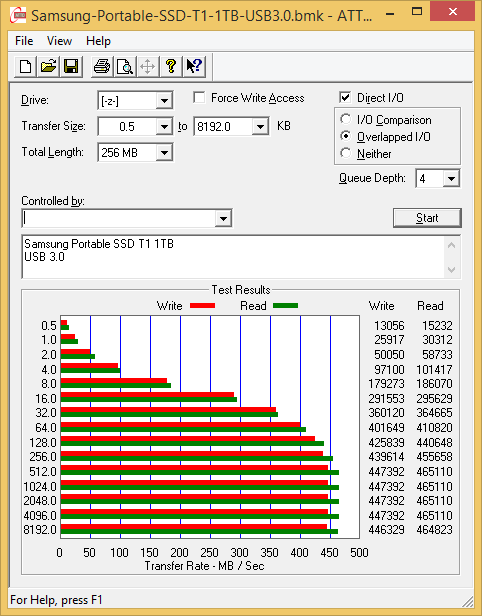
CrystalDiskMark, despite being a canned benchmark, provides a better estimate of the performance range with a selected set of numbers. As evident from the screenshot below, the performance can dip to as low as 26 MBps for 4K accesses at very low queue-depths. It can already be seen from the two benchmarks that enabling encryption doesn't alter the transfer rates at all.
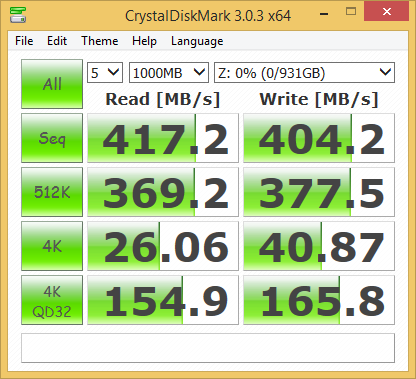
Benchmarks - robocopy and PCMark 8 Storage Bench
Our testing methodology for DAS units also takes into consideration the usual use-case for such devices. The most common usage scenario is transfer of large amounts of photos and videos to and from the unit. The minor usage scenario is importing files directly off the DAS into a multimedia editing program such as Adobe Photoshop.
In order to tackle the first use-case, we created three test folders with the following characteristics:
- Photos: 15.6 GB collection of 4320 photos (RAW as well as JPEGs) in 61 sub-folders
- Videos: 16.1 GB collection of 244 videos (MP4 as well as MOVs) in 6 sub-folders
- BR: 10.7 GB Blu-ray folder structure of the IDT Benchmark Blu-ray (the same that we use in our robocopy tests for NAS systems)
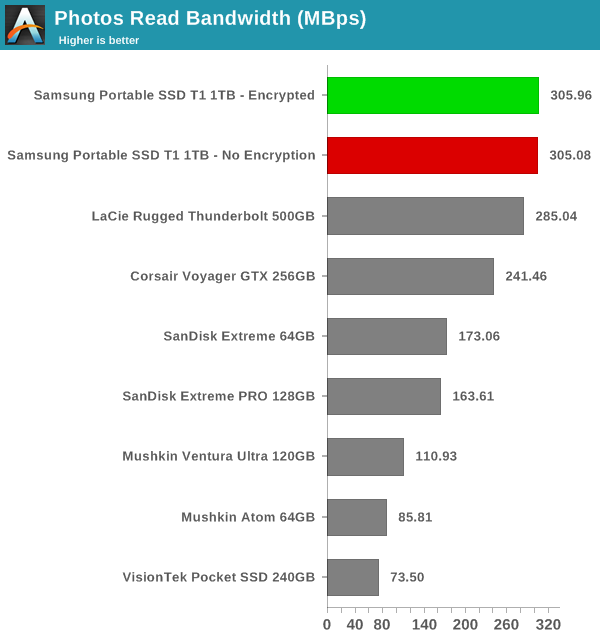
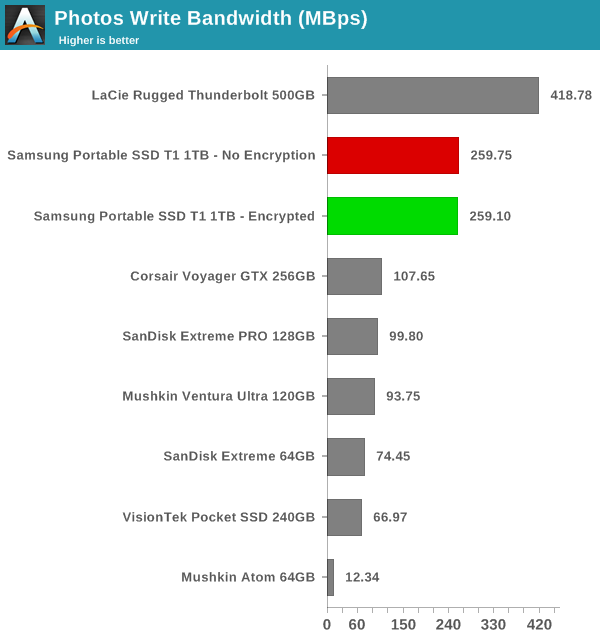
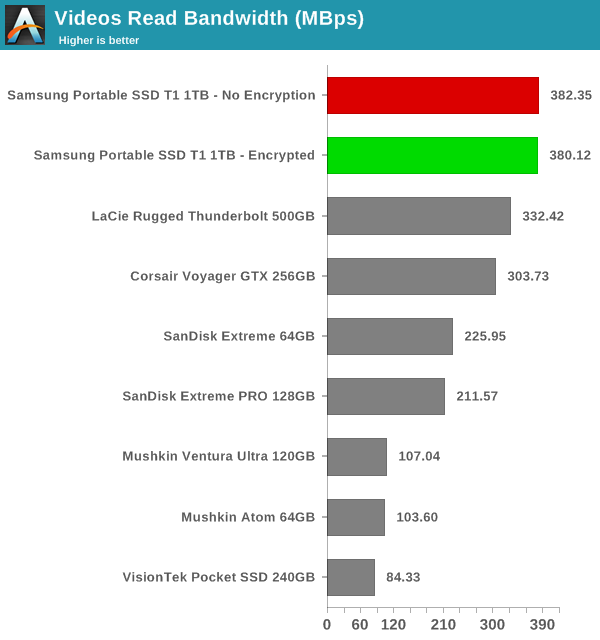
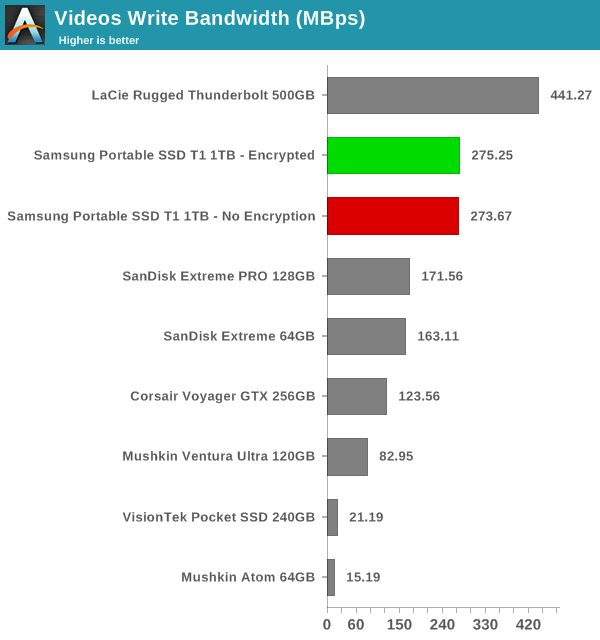
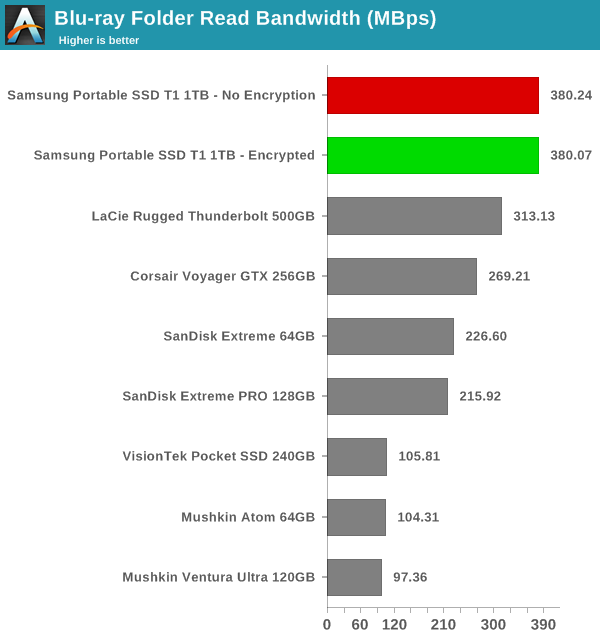
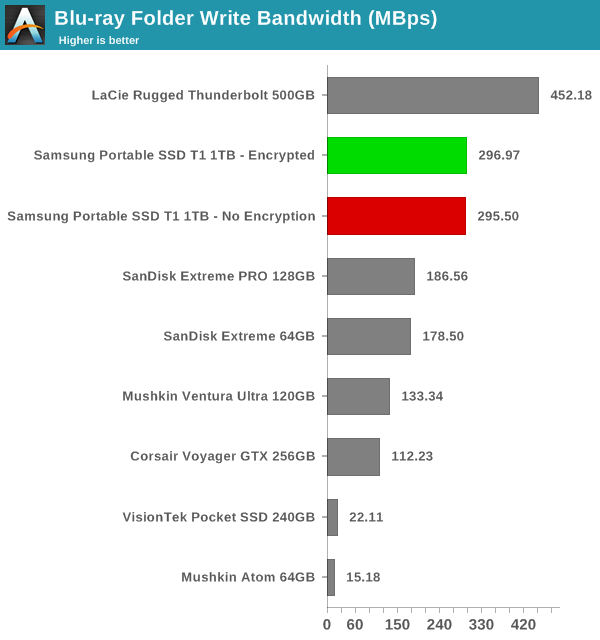
For the second use-case, we take advantage of PC Mark 8's storage bench. The storage workload involves games as well as multimedia editing applications. The command line version allows us to cherry-pick storage traces to run on a target drive. We chose the following traces.
- Adobe Photoshop (Light)
- Adobe Photoshop (Heavy)
- Adobe After Effects
- Adobe Illustrator
Usually, PC Mark 8 reports time to complete the trace, but the detailed log report has the read and write bandwidth figures which we present in our performance graphs. Note that the bandwidth number reported in the results don't involve idle time compression. Results might appear low, but that is part of the workload characteristic. Note that the same testbed is being used for all DAS units. Therefore, comparing the numbers for each trace should be possible across different DAS units.
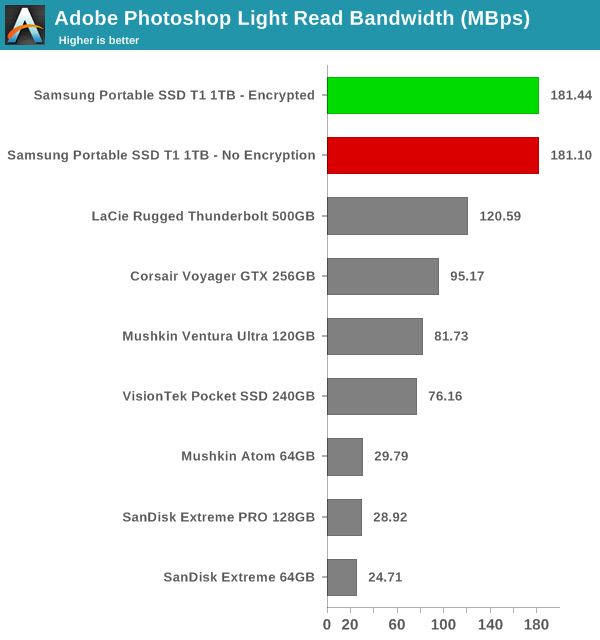
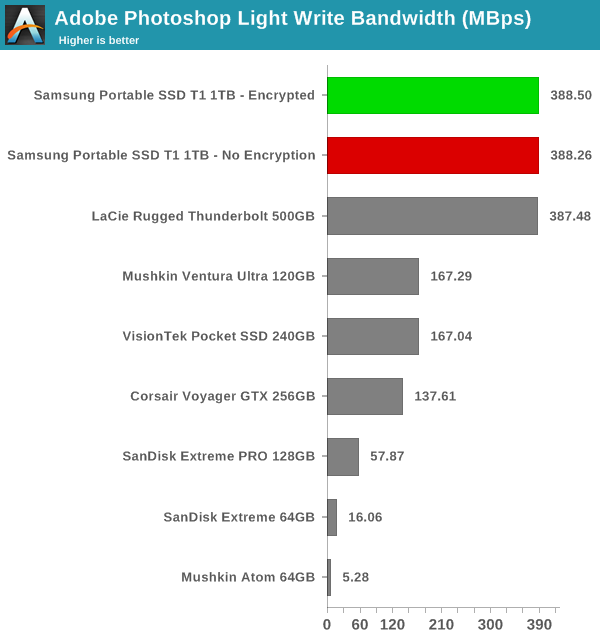
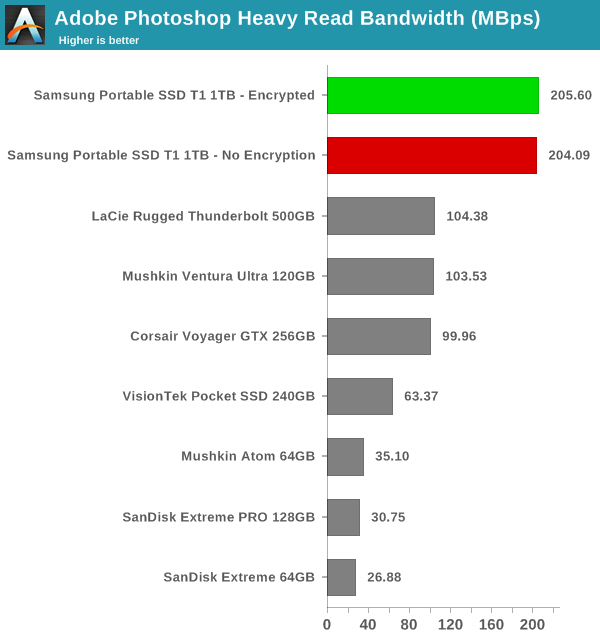
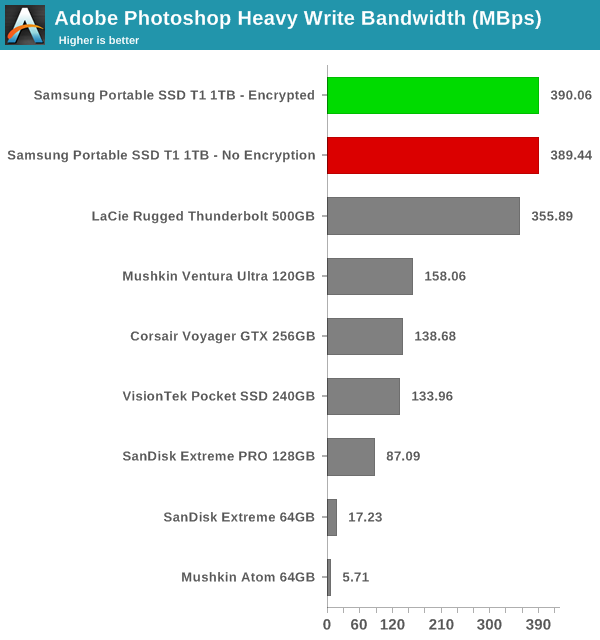
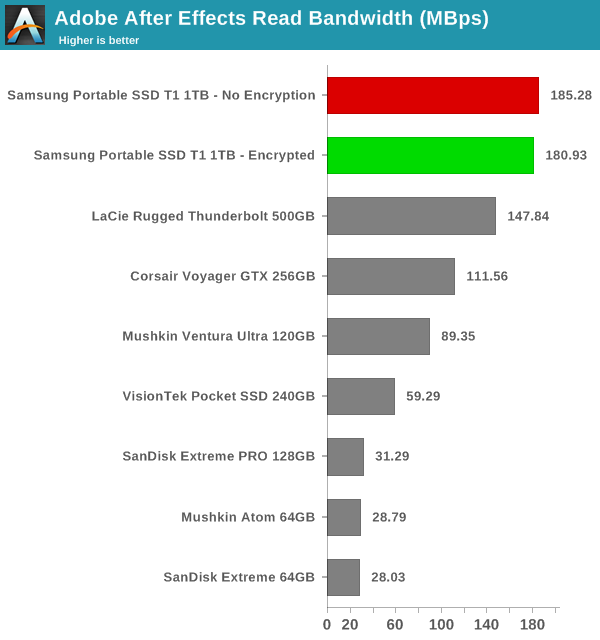
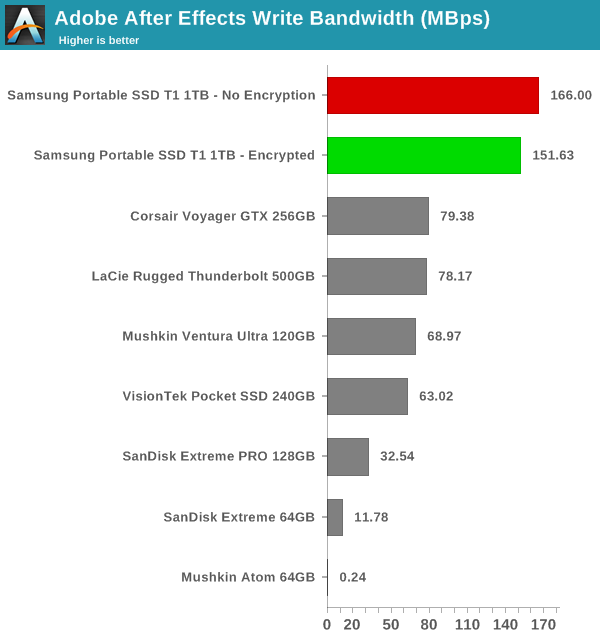
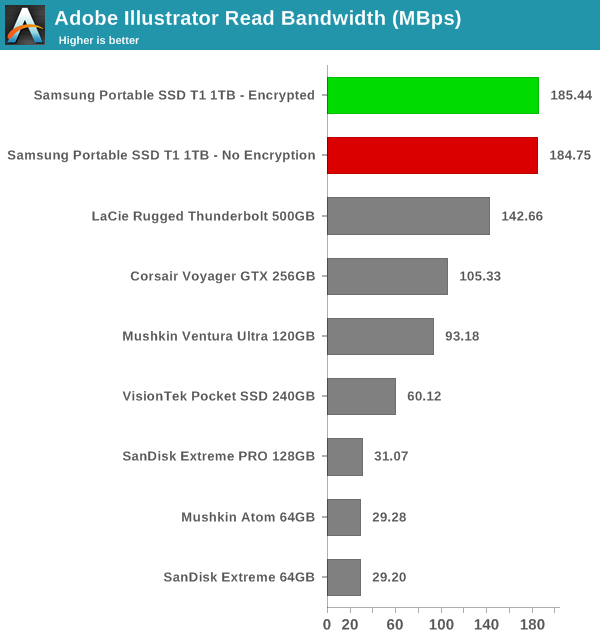
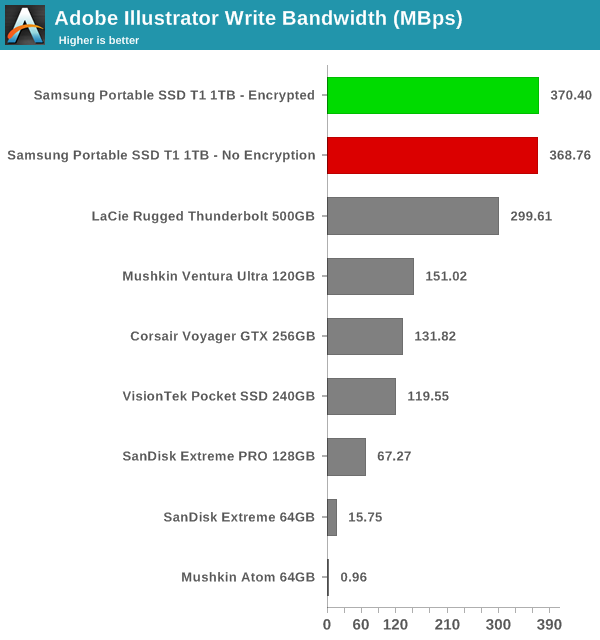
The 1TB Portable SSD T1 manages to win almost all the benchmarks, losing out on a couple of traces to the LaCie Rugged Thunderbolt 500GB version (which, incidentally, carries a Samsung PM851 behind a USB 3.0 - SATA bridge).










68 Comments
View All Comments
galfert - Tuesday, January 20, 2015 - link
No TRIM....then no thanks. I'll keep my Corsair Voyager GTX for now.tipoo - Tuesday, January 20, 2015 - link
Do any drives do TRIM over USB 3?tipoo - Tuesday, January 20, 2015 - link
Ah, there it is, there's at least one device that does but most don't.Wwhat - Sunday, February 8, 2015 - link
Since internally it's just a slotted SSD module you could theoretically open the case, unplug it and stick it in your computer and trim it then.Samus - Tuesday, January 20, 2015 - link
The thing is...the write performance of the Voyager GTX is so poor in comparison to the Samsung T1, that even with TRIM support, it's slower at peak (after TRIM) than the Samsung is at its lowest point of consistency. Factor in the Voyager doesn't come in 1TB configuration and costs more per GB, you'd be crazy to buy the Voyager GTX over this.akdj - Tuesday, January 20, 2015 - link
I'm with ya Samus. Samsung is 'well' into it's design and reliability when it comes to flash, NAND, PCIe and SSD storage solutions. You'll be looking at a dime a GB by the time your T1 begins to bum out (due to lack of TRIM/S.M.A.R.T support over USB). Unless you're 'truly' using After Effects or manipulating massive RAW PS files and layers all day, every day I'm not sure it's even a concern anymore. Especially in the consumer segment.Servers and enterprise with massive user volume this may not be the perfect choice. For most, wow. A TB with these speeds and performance/heat & (lack of) throttling IMHO is a Home Run!
I've been using a 2012 15" rMBP daily, since launch with a 768GB, pre PCIe SSD. It's (still) mind numbingly quick using it's internal and external Lacie TBolt SSD. Not a single issue with the laptop or external 500GB SSD after 30 months and ten, respectively. Never a glitch
I'm sold. Will Thunderbolt allow for TRIM support?
Has Samsung built anything with Thunderbolt connectivity yet?
Thanks for the review.
J
Kutark - Tuesday, January 20, 2015 - link
In my limited knowledge, who would really need that type of speed/storage? I'm guessing for most people, even in the IT field, a 64gb or 128gb high speed USB drive is going to be more than fast enough / sufficient space. The only place i could see this being of high need would be professional photographers? I'm sure there's probably some situations out there i'm not aware of, so please correct me if i'm wrong.Basically what i'm saying is for a person who has capacity needs, a regular portable is going to be massively cheaper. For a person who has speed needs, most of the high speed USB drives are very cost effective and have good speeds vs cost. So, i'm wondering how big of a subset of people need both a lot of capacity AND a lot of speed that can justify the cost of this beast.
Laststop311 - Wednesday, January 21, 2015 - link
Not just photographers. If you are a video editor and want to have portability of your raw files on a drive 1TB should be enough space for a fairly long video and if they edit insane amounts of video they can easily buy more of them. This read transfer speed is super important for a video editor to save a ton of time transferring huge 500GB files. Also there really isn't much other choice for 1TB of space and raw uncompressed HD video needs a huge amount of space and because it's so large every drop of speed they can get the need.tipoo - Friday, January 30, 2015 - link
I sometimes have to use multiple VMs off a single external drive, SSD speeds (even across USB 3) would be a godsend for that.designerfx - Tuesday, January 20, 2015 - link
Not just that, but guaranteed heatdeath with time. Most consumer electronics aside from obvious exceptions are not built for operations at 75c, and their throttling simply confirms it. Adding vents to the "portable ssd" won't fix the fact that it's being put in an enclosure.